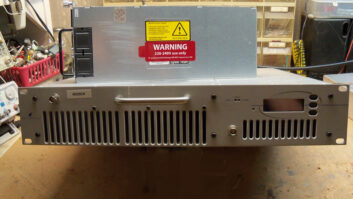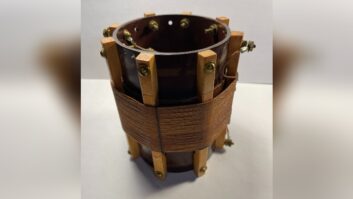New Hampshire Public Radio’s Steven Donnell sends in a simple critter anti-climb guard. He placed it around a coaxial line at a transmitter site.

Fig. 1: The base from a flower pot discourages animals from climbing outdoor coax.
Shown in Fig. 1, the guard consists of a base from a large plastic flower pot that Steven purchased at a big box store. The base has a 2-inch hole in the center that fits perfectly around the 1-5/8-inch line. Steven cut a slit in the plastic to slide it onto the line and used a hose clamp along with a couple of zip ties to hold it in place.
This prevented some pesky critter (Steven suspects it was a porcupine) from climbing the line and chewing on some of the smaller cables.
***

Fig. 2: Microphone cable terminated in an XLR.

Fig. 3: However, turning the boom can rip the cable from the connector.
So here’s a question for our readers: When mounting studio microphone booms, and running the mic cable down to a desk-mounted XLR plug, as shown in Fig. 2, how do you prevent the cables from becoming twisted around the boom?
As pictured in Fig. 3, the twisting of the boom eventually stresses and pulls the soldered wires from the connector. Send in your solutions!
***
Florida engineer John Collinson wrote about the Sencore Z Meter several issues back. It’s an excellent test instrument for troubleshooting to the component level. The snag was what to do if the unit needed repair.
After a number of calls and an in-person discussion with a Sencore representative at the NAB Show, it turns out it’s not an “all or nothing” thing. Sencore will repair some of their pieces of legacy test equipment, but unfortunately the technician who was assigned to the Z-meter line of test equipment left the company last year and apparently has not been replaced.
John notes that the service manager with whom he was corresponding was very cooperative and gave several hints and helps in troubleshooting. Schematics may possibly be available for a reasonable charge, bearing in mind that one of their ongoing nemeses is parts becoming obsolete.
For repair on other Sencore test equipment, it’s likely worth contacting them to explore the possibilities. They seem willing to help to the extent they can.
***

Fig. 4: A compact XLR-to-RJ-45 connector adaptor.

Fig. 5: Fig. 5: The small adaptor works well when space is at a premium.
Fig. 4 shows a SESCOM model XLRJ45 used by Larry Holtz and Phil Biehl at All Classical Portland. This is a compact adaptor used to convert an XLR to an RJ-45 connector.
You can also see in Fig. 5 how compact it is. The adaptor makes it possible to use Ethernet cable and is available in four versions: a three-pin male or female XLR or a five-pin male or female XLR.
The adaptors are sold by Markertek (www.markertek.com). Search “Sescom DMX-3XM” or “DMX-3XF” in the Markertek search block for more information.
***
WETA(TV) engineer Bill Seabrook comments on the measurement of capacitor electrical series resistance, as discussed in the May 24column.
From the online Digi-Key Techzone articles, equivalent series resistance describes losses associated with moving charge through a capacitor. The resistance of the electrode and lead materials is a contributing factor, and losses occurring within the dielectric material itself also occur and are often dominant.
The relevance of ESR to capacitor selection is two-fold: 1) It influences the AC response of the capacitor, and 2) it imposes limits on the amount of AC current that can be permitted to flow through the capacitor due to thermal limitations. Current flow through a capacitor’s ESR results in I2R losses just like any other resistor, causing a temperature increase within the capacitor that contributes to diminished device longevity.”
Bill recommends the EDS-88A CapAnalyzer, for measuring ESR. This instrument has saved him hours of time in finding defective capacitors, without having to remove them from the circuit boards.
Like many of the capacitor analyzers on the market, the EDS-88A permits analysis of a board consisting of dozens of components in just a few minutes. Search “ESR capacitor analyzer” for a variety of offerings.
***

Fig. 6: The cover of an offering from Raychem.
For higher-voltage protection, follow this link to a PDF from Raychem.
Chuk Gleason’s wife used to work for Raychem as a quality control engineer. Chuk hails from Cary, N.C., and Raychem’s insulation enhancement system is an interesting solution to squirrels or other climbing animals shorting out high-voltage transformers and lines. Find out more at http://raychemrpg.com/epd/pdf/ insulation_enhancement_system.pdf.
Contribute to Workbench. You’ll help your fellow engineers and qualify for SBE recertification credit. Send Workbench tips to [email protected]. Fax to (603) 472-4944.
Author John Bisset has spent 46 years in the broadcasting industry and is still learning. He handles West Coast sales for the Telos Alliance. He is SBE certified and is a past recipient of the SBE’s Educator of the Year Award.












